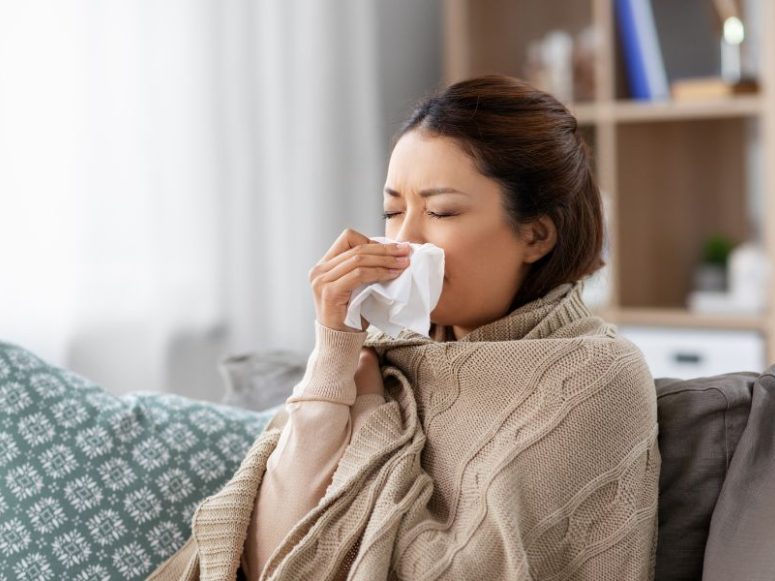Key Points
- Viral infections cause most nose cold symptoms, lasting 7-10 days with peak symptoms occurring on days 2-3, making symptom management more important than attempting to cure the underlying infection.
- Saline irrigation and steam inhalation provide 60-80% improvement in nasal congestion symptoms within 24 hours, offering safe and effective relief without medication side effects.
- Medical attention is needed when symptoms persist beyond 10 days, include fever above 101.3°F, or involve severe sinus pain, as these may indicate bacterial infections requiring antibiotic treatment.
Nose cold symptoms including nasal congestion, runny nose, and sinus pressure are among the most common health complaints, affecting millions of people each year. Understanding effective treatment strategies helps you find relief while knowing when professional medical care is necessary.
Most nose cold symptoms result from viral upper respiratory infections that resolve on their own with supportive care. However, proper symptom management can significantly improve comfort and speed recovery while preventing complications.
Understanding Nose Cold Symptoms
Common Viral Causes
The majority of nose cold symptoms result from viral infections including rhinoviruses, coronaviruses, and other respiratory viruses. These infections cause inflammation in the nasal passages and sinuses, leading to congestion, runny nose, and related symptoms.
Viral infections typically follow a predictable course, with symptoms beginning gradually, peaking around days 2-3, and gradually resolving over 7-10 days.
Symptom Progression
Early symptoms often include throat irritation and mild nasal congestion, progressing to more significant congestion, runny nose, sneezing, and sometimes low-grade fever. Understanding this progression helps set realistic expectations for recovery.
Distinguishing Viral from Bacterial Infections
Viral infections typically cause clear or white nasal discharge, while bacterial infections may produce yellow or green discharge. However, discharge color alone isn't definitive, and other factors help distinguish between viral and bacterial causes.
Effective Home Remedies
Saline Nasal Irrigation
Saline irrigation using neti pots, squeeze bottles, or saline sprays effectively clears nasal passages and reduces congestion. This treatment flushes out irritants and excess mucus while moisturizing nasal tissues.
Use distilled, sterile, or previously boiled water mixed with salt to create isotonic saline solution. Perform irrigation 2-3 times daily for best results.
Steam Inhalation
Inhaling steam from hot showers, steam bowls, or humidifiers helps loosen mucus and reduce nasal congestion. The warm, moist air soothes irritated nasal passages and promotes drainage.
Add mentholated products like eucalyptus oil to steam for additional decongestant effects, but use sparingly to avoid irritation.
Hydration and Rest
Staying well-hydrated helps thin mucus secretions, making them easier to clear from nasal passages. Drink plenty of water, herbal teas, and warm broths to maintain hydration.
Adequate rest supports immune function and helps your body fight off viral infections more effectively.
Humidification
Using humidifiers or breathing moist air helps prevent nasal passages from drying out, which can worsen congestion and irritation. Maintain indoor humidity levels between 30-50% for optimal comfort.
Over-the-Counter Medications
Decongestants
Oral decongestants like pseudoephedrine and phenylephrine can provide temporary relief from nasal congestion by reducing swelling in nasal blood vessels. These medications are most effective for short-term use.
Nasal decongestant sprays provide rapid relief but should not be used for more than 3 days to avoid rebound congestion, which can worsen symptoms.
Antihistamines
Antihistamines may help reduce runny nose and sneezing, particularly if allergies contribute to symptoms. First-generation antihistamines like diphenhydramine may cause drowsiness, while newer antihistamines are less sedating.
Pain Relievers
Acetaminophen or ibuprofen can help reduce sinus pain, headache, and fever associated with nose cold symptoms. Follow package directions and don't exceed recommended dosages.
Combination Medications
Many over-the-counter cold medications combine decongestants, antihistamines, and pain relievers. While convenient, these combinations may include ingredients you don't need and can increase the risk of side effects.
Natural and Alternative Remedies
Honey and Warm Liquids
Honey has antimicrobial properties and can soothe throat irritation while warm liquids help thin mucus and provide comfort. Add honey to herbal teas or warm water for symptom relief.
Chicken Soup
Chicken soup provides hydration, warmth, and nutrients while the steam helps with congestion. Some research suggests chicken soup may have mild anti-inflammatory effects that support recovery.
Vitamin C and Zinc
While evidence is mixed, some studies suggest vitamin C and zinc supplements may slightly reduce the duration of cold symptoms when taken early in the illness.
Essential Oils
Eucalyptus, peppermint, and tea tree oils may provide decongestant effects when used in steam inhalation or diffusers. Use these oils sparingly and avoid direct application to skin or nasal passages.
When to Seek Medical Care
Duration of Symptoms
Seek medical attention if nose cold symptoms persist beyond 10-14 days, as this may indicate a bacterial sinus infection requiring antibiotic treatment.
Fever and Severe Symptoms
High fever (above 101.3°F), severe sinus pain, facial swelling, or severe headache may indicate bacterial infection or other complications requiring medical evaluation.
Worsening Symptoms
If symptoms initially improve but then worsen significantly, this may suggest secondary bacterial infection or other complications requiring medical attention.
Chronic or Recurrent Symptoms
Frequent episodes of nose cold symptoms may indicate underlying conditions such as allergies, chronic sinusitis, or immune system problems that require medical evaluation.
Complications to Watch For
Bacterial Sinusitis
Bacterial sinus infections can develop as complications of viral colds, particularly when symptoms persist or worsen after initial improvement. These infections typically require antibiotic treatment.
Ear Infections
Nasal congestion can lead to ear infections, particularly in children, when blocked eustachian tubes prevent proper ear drainage.
Asthma Exacerbation
People with asthma may experience worsening symptoms during viral respiratory infections, requiring adjustment of asthma medications and close monitoring.
Prevention Strategies
Hand Hygiene
Frequent handwashing with soap and water for at least 20 seconds is the most effective way to prevent viral respiratory infections that cause nose cold symptoms.
Avoiding Sick Contacts
Limit close contact with people who have cold symptoms, and avoid touching your face after contact with potentially contaminated surfaces.
Immune System Support
Maintain good overall health through adequate sleep, regular exercise, healthy diet, and stress management to support immune function and reduce susceptibility to infections.
Environmental Factors
Avoid exposure to cigarette smoke and other irritants that can worsen nasal symptoms and increase susceptibility to respiratory infections.
Special Considerations
Children and Infants
Children may require different treatment approaches, and certain medications are not appropriate for young children. Consult pediatric healthcare providers for age-appropriate treatment recommendations.
Pregnancy
Pregnant women should consult healthcare providers before using medications for nose cold symptoms, as some treatments may not be safe during pregnancy.
Chronic Conditions
People with chronic conditions such as asthma, diabetes, or immune system disorders may need modified treatment approaches and closer medical monitoring during respiratory infections.
Does Blowing Your Nose Make Congestion Worse?
Find Out Here
Recovery and Return to Activities
Gradual Activity Resumption
Return to normal activities gradually as symptoms improve, avoiding strenuous exercise until you feel completely well to prevent symptom recurrence.
Contagiousness Considerations
You're typically most contagious during the first 2-3 days of symptoms when viral shedding is highest. Consider staying home from work or school during this period to prevent spreading infection.
Follow-Up Care
Monitor symptoms for improvement and seek medical attention if symptoms worsen or don't improve as expected within the typical timeframe.
Conclusion
Nose cold symptoms are common and usually resolve with supportive care and time. Effective home remedies including saline irrigation, steam inhalation, and adequate hydration provide significant relief for most people. Over-the-counter medications can help manage symptoms when used appropriately.
Understanding when to seek medical care ensures that complications are identified and treated promptly. While most nose cold symptoms resolve without medical intervention, persistent or severe symptoms may require professional evaluation and treatment. Focus on symptom management, prevention strategies, and gradual return to normal activities as you recover from viral respiratory infections.
References:
[1] American Academy of Otolaryngology. "Runny Nose." https://www.enthealth.org/conditions/runny-nose/
[2] Centers for Disease Control and Prevention. "Common Colds: Protect Yourself and Others." https://www.cdc.gov/features/rhinoviruses/
[3] Mayo Clinic. "Common Cold." https://www.mayoclinic.org/diseases-conditions/common-cold/symptoms-causes/syc-20351605








